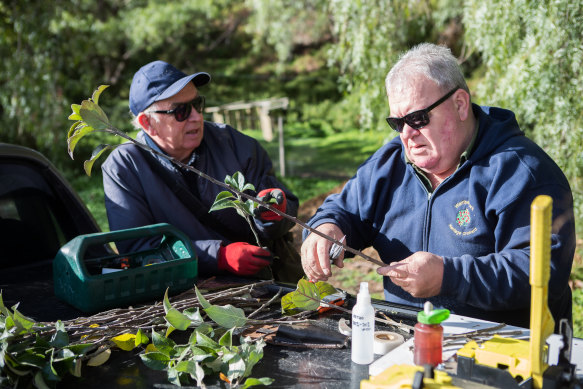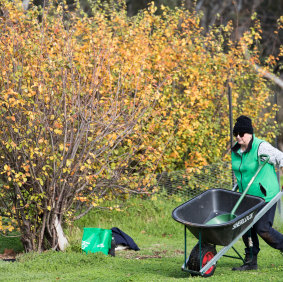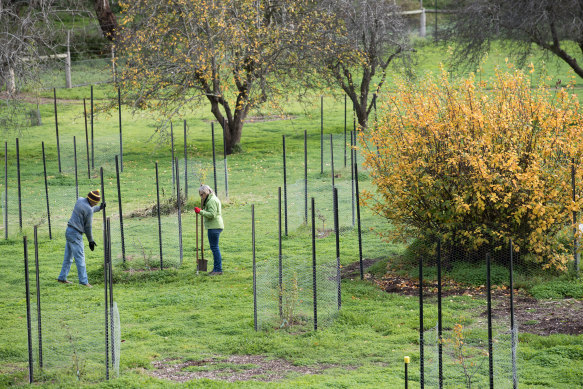By Megan Backhouse
Craig Castree never goes anywhere without his grafting knife. It's always in his back pocket and he can slide it out and unfold its flat stainless steel blade with his eyes closed. The first plant he ever grafted was a blue spruce. He was a 15-year-old gardening apprentice and the propagation technique failed to hook him.

Craig Castree, right, and one of the volunteers at the Werribee Park.Credit: Jason South
But by the time he was in his early 20s, he was transplanting parts of one plant onto another in his spare time. At 21, he grafted 20 different plum varieties to the old plum growing in his Sunbury back garden – because he could and also because it thrilled him to see this one tree sporting flowers in all sorts of colours; mauve, pink, crimson.
Most didn’t yield much fruit. “It was more about the colours,” he says. In recent years, though, it has been very much about the fruit. Ever since he visited the Werribee Park Heritage Orchard in 2010 he has been helping to reinvigorate the orchard, first planted almost 150 years ago, by grafting heirloom fruit trees.
“I hadn’t grafted for probably 10 years then but I bumped into this bloke who was bud-grafting peaches and he said, we need people like you. I went down there the following Saturday and I fell in love the place and I have been every week since,” Castree says.
For the past four years he has been president of the Werribee Park Heritage Orchard Committee. The outfit has more than 100 volunteers, up to 50 of who gather – to graft, prune, fruit-thin – at the orchard on Friday mornings.

Volunteers at the Werribee Park Heritage orchard. Credit: Jason South
Castree is always on the lookout for unusual varieties that the orchard has lost. Last month, he and a group of volunteers visited a heritage apple grower in Apollo Bay with 200 different apples. A swap was done. In return for the Werribee crew taking pencil-thick stem cuttings – or scion – from varieties the orchard no longer holds, Castree is helping the Apollo Bay apple grower source scion from some of the varieties he has lost.
The diversity of apples Werribee is amassing makes a mockery of the narrow band of offerings we see at supermarkets. There are apples that taste wonderful straight off the tree but turn floury within a week of being picked, there are thin-skinned apples that are easily bruised, ones that look ugly and misshapen but that taste crisp and sweet. There is such a broad range that the orchard has ripe apples from March to July.
It’s the same with all the orchard’s fruit trees, first planted by Scottish-born pastoralist Thomas Chirnside in the early 1870s. Chirnside cultivated hundreds of peaches, apples, quinces, pears and plums. He selected different grapes, walnuts and olives. They were all relished and for a long time the place flourished.
But by the mid-1970s Werribee Park was in public hands and the fruit trees were left untended. Drought, flooding and rabbits all took a toll. It was three decades before people started to see the magnitude of the loss.

Werribee Park Heritage Orchard Committee has more than 100 volunteers.Credit: Jason South
By 2010, when the community group was formed – in partnership with Parks Victoria – to look after the orchard, some of the pears were on a golf course and many olives had given way to a polo field.
Given many fruit trees don't run true-to-type when propagated by seed, all of the group’s propagation is done by grafting. While it is the scion that determines the nature of the fruit produced by a grafted tree, it is the rootstock that helps determine how vigorous the tree is, the soil it likes and its ultimate size.
The Werribee volunteers use MM102, a semi-dwarfing rootstock, selected and developed last century at the East Malling Research Station in Kent, for apples, and they are using the nematode-resistant Nemaguard rootstock for peaches, nectarines, plums and apricots.
Castree will be give grafting demonstrations at this month’s Heritage Fruit Tree Festival, which will also include scion and root stock sales. The orchard has been holding this festival (previously called the Winter Fruit Tree Grafting Day) for seven years and it has become the biggest grafting event in Australia, attracting more than 3500 people last year.
Castree says, once mastered, grafting is “like any sort of plumbing”. “You want to connect the cambium layers just inside the bark (of scion and rootstock.) If you miss a bit and it doesn't connect then there is no flow. But if you can get sap flow, hey presto, you have a graft.”
The Heritage Fruit Tree Festival is on July 28, 10am-3pm, at Werribee Park Heritage Orchard, enter via Gate 5, K Road, Werribee South.